|
TrophyCatch Season 11, the Season of Research, concluded on September 30, but you still have until OCTOBER 15 to submit any bass caught from October 1, 2022 through September 30, 2023. Check your phone for any unsubmitted bass just waiting to be ushered into TrophyCatch!
Although we will still be reviewing catches submitted by the upcoming deadline, here are some of the most recent available numbers and a few of our Season 11 highlights:
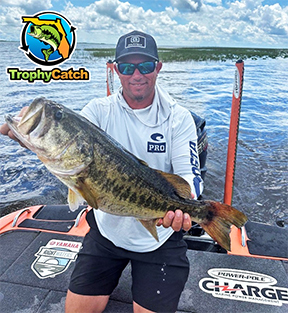 |
|
Pro angler and TrophyCatch advocate Bobby Lane got into the action this season with a very nice 9 lbs. Lake Kissimmee bass. Great catch and thank you for your amazing support! |
Miller Polly joined an elite group of anglers with his Hall of Fame catch! This 13 lbs. 4 oz. giant was caught-and-released in Lake George. This was the very first Hall of Fame bass from Lake George, a part of the St. Johns River. A lifetime achievement for Miller and this big fish still swims! |
|
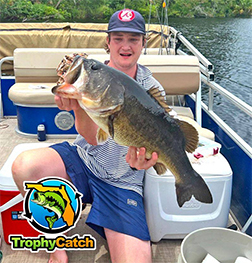 |
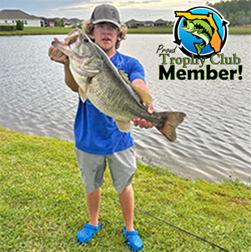 |
|
You don't need a big-name lake to catch a big fish! Jayden Shumbera caught this nice 10-pounder from an Osceola County neighborhood pond. This fish was within easy walking distance for this angler, here in Florida, the Bass Fishing Capital of the World! |
Currently as we approached the end of Season 11, TrophyCatch submission numbers stand at:
- 11,498 Lunker Club (8-9.9 lbs.)
- 2,880 Trophy Club (10-12.9 lbs.)
- 140 Hall of Fame (13+ lbs.)
- 14,518 TOTAL approved submissions to date
The new season is right around the corner! If you haven't already registered for TrophyCatch, please don't wait until a trophy strikes to show your support for bass conservation — be counted NOW and register at TrophyCatch.com.
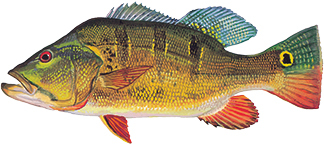
Size: State Record is 9.11 pounds, but fish up to 12 pounds have been caught. The Big Catch minimum qualifying sizes are 4 pounds or 18 inches for adults, and 3 pounds or 13 inches for youth (see BigCatchFlorida.com).
Appearance: Body shape similar to that of a largemouth bass; color is highly variable, but generally golden with three black vertical bars that tend to fade and are possibly absent in older fish; black spot with a yellow-gold halo on the tail fin. Occasionally Mayan cichlid are mistaken for peacock bass but have 6-8 vertical bars and a turquoise ring on the tail.
Range & Habitat: Successful in warm, slow flowing canals, ponds, lakes, deep rock pits, and lateral canals; frequently found in shady areas around bridges, culverts, canal intersections, bends, dead ends, and near fallen trees. Spawns and often feeds in shallow water adjacent to shorelines with overhanging vegetation; cannot tolerate water temperatures below 60 degrees F or salinities greater than 18 ppt. Native to the Amazon River basin of South America and introduced by FWC in coastal canals of southeast Florida in 1984 for controlling over-abundant nonnative forage fishes.
Sporting Quality: One of the most popular sportfish in south Florida canals where it generates millions of hours of fishing pleasure for thousands of anglers who spend more than $8 million a year to catch them; available to both boat and bank anglers using the same basic tackle as largemouth bass anglers. Small shiners are the preferred live bait; rarely take plastic worms like largemouth bass do, but top-water lures, minnow imitating crank and jerk baits, and marabou jigs are popular artificial baits. Streamers, epoxy minnows and pencil poppers are favorites of fly fishers. See the Metropolitan Southeast Florida Canals Fishing Forecast for some of the best and most popular fishing locales.
Fish illustration by Duane Raver, Jr.
|
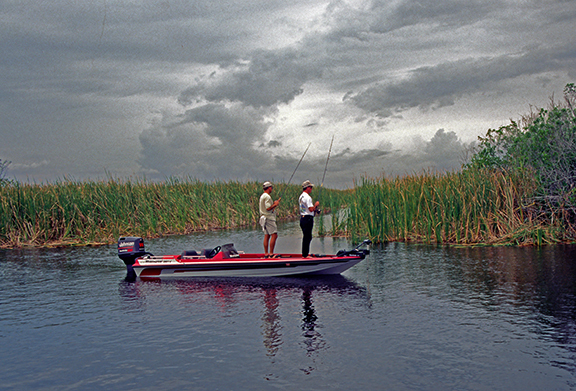 |
Don't waste your phone making calls — use it to catch more fish! We continue looking at the versatile tools available to anglers on modern smartphones. One of the most important choices for staying safe outdoors is a good Doppler radar app that can tell you if the storm above is heading your way!
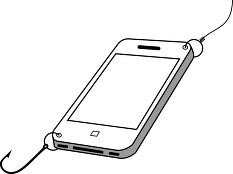
Last issue we got an introduction to the modern piece of technology known as the "smartphone," and began taking a look at how having one of these amazing gadgets in your pocket can help you catch more fish. We'll continue that discussion here.
One of the most helpful apps (or programs) for modern smartphones is Doppler radar. This gives real-time rain information wherever you are. Various apps are available, but those touting high definition and lightning detection will be much more helpful. Time-lapse display allows you to estimate the direction and size of rain patterns. For a personal example, my very first radar app paid for itself the day after I bought it. The forecast had predicted scattered showers. But after a miserable hour of fishing in heavy rain I kept expecting to break up, I finally pulled out my phone and could see using my new app that the "scattered" rain pattern had actually stalled over my entire fishing area. I called it quits and went home to do indoor activities for the rest of the day. On the other hand, there have been times when my app has allowed me to keep fishing rather than throwing in the towel. On one outing, I spent six hours fishing in a narrow band of clear weather nestled between two major rainstorms immediately north and south of me. Normally what I saw looking around me would have had me hopping in my car and heading home. But my app showed both storms to be free of lightning and holding stationary, so (checking the app regularly) I decided to stay put. It was actually one of my more productive fishing days, with a nice five-pounder thrown in to top it off. I would definitely have stopped fishing sooner—and missed a great day—without the app. Choose an app that will show lightning, and make sure that notifications (alerts) for that app are enabled (turned on) to warn you if there is lightning nearby. CAUTION: Rain is one thing and lightning another. Always exercise caution near thunderstorms and leave the area or seek safety immediately if lightning threatens. Also, despite the advanced technology that modern radar offers, storms are unpredictable. Always assume that a storm will strengthen and turn your way unexpectedly and plan enough time for a safe exit from the area at a moment's notice.
|
 Dozens of informative PDFs can be saved to your smartphone's memory and accessed with no need for a good cell tower connection. Examples include fishing regulations, fishing identification booklets, and maps.
Another great use for a smartphone is as a small-screen digital reader. Any digital document that you can find or convert to PDF (Adobe Acrobat portable document format) can be stored and viewed on most smartphones. Examples of documents that you can save to your phone's files and carry digitally with you wherever you go—no cell tower connection needed!—include the fresh and saltwater fishing regulations, FWC’s “Fishing Lines” magazine (which includes a saltwater fish identifier), FWC’s South Region Angler Guides canal maps collection (see our Fishing Forecasts at Bit.ly/AnglerGuide), and the local Water Management District’s canals and structures map. With your phone in hand, you can be a walking map atlas and fishing encyclopedia!
Besides general-use apps that may be useful for fishing, there are also specific fishing apps. Solunar tables, tide information, fish identification, fly fishing references, fishing spot maps, fishing trip advisors—there’s quite a bevy of helpful apps out there, including those mentioned last issue (FWC's Fish / Hunt FL app, Fishbrain, and Fish Rules which are all must-haves). There are too many apps to cover here, but you can search online for any of these or other keywords to find what might be helpful to you. Checking an app’s rating and reading some reviews will give you an idea if an app will really do what you want. Some, like Fish Rules, are completely free while others have a usually-nominal cost.
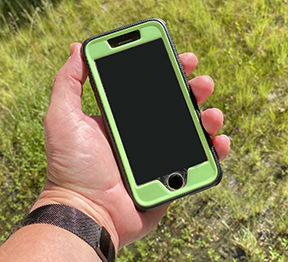
A bevy of accessories are available for smartphones. The most important, hands-down, is a good case. Delicate electronics and the rugged (and wet) outdoors don’t mix, and protecting your phone from the elements is a must. There are literally hundreds of styles and colors, but consider a case made of a non-slip material such as silicone so that it’s not easily dropped. If you’re a kayak or wade angler, a waterproof phone case is highly recommended. Make sure you pick one for your specific phone model! If your case doesn’t include a screen cover of some kind, then a screen protector is a good accessory to add—though phone screens are much more scratch-resistant than they used to be. A car charger or external power pack that can be charged via a USB connector and then plugged into your phone miles away from the nearest electrical outlet is another great convenience.
|

While smartphones themselves are small computers, depending on your smartphone and your desired functionality you may end up using a home computer to take full advantage of some of the features mentioned here. Connecting a phone to your computer will allow you to download and store the photos you’ve taken, put handy reference documents or other information on your phone, or perform less important non-fishing functions (like load music or audiobooks for those longer drives to the lake).
Keep in mind that features, capabilities, apps, and accessories will vary in function and availability depending on your cell phone service provider, phone platform (iPhone or Android for example), and the actual phone model you have. However, similar functionality to everything discussed above is available on most smartphones, and they can all do some pretty amazing things. Although the first iPhone came out in 2007, only about 15 years ago, even old-timers may have a hard time imagining day-to-day life without one today!
|
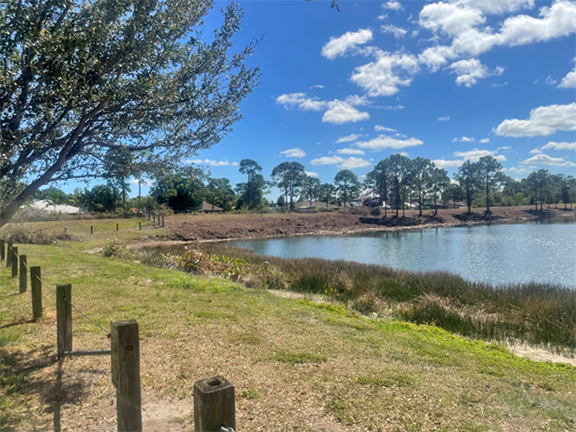 |
Size: 100 acres
Location: St. Lucie County
Description: O.L. Peacock Sr. Park is located in St. Lucie County. Peacock Park Lake is a great destination for those who enjoy viewing wildlife and fishing. In 2022, the lake used to be covered with Brazilian pepper as well as other invasive aquatic vegetation. FWC and staff from the City of Port St. Lucie worked together to remove four acres of Brazilian pepper as well as two acres of invasive aquatic plants to provide better habitat for fish and wildlife and improve access for anglers. Workers planted native vegetation in and around the lake including pickerelweed, swamp lily, bulrush, spikerush, smartweed, and cypress trees. FWC staff will continue to monitor the success of the newly planted vegetation.
The lake was sampled in October 2022 by electrofishing to survey the fish community. The most abundant fish in the lake was bluegill and the second most abundant was largemouth bass. Other fish sampled in the lake consisted of Florida gar, Mayan cichlid, redear sunfish, and warmouth.
Boating/Parking:
- Only electric motors are permitted for use; gasoline powered motors are prohibited.
- A grass parking area is located on the Northeast side of the park.
Bluegill and redear sunfish are popular and cooperative panfish found near vegetation or structure. Live worms or crickets fished a few feet under a small bobber are a sure bet. Doughballs and small pieces of cut hot dog also work well. Good lures include small jigs, beetle spins, and tiny spinners. Flyrod anglers can score with small popping bugs, wet flies, and nymphs.
Standard largemouth bass lures including plastic worms, minnow imitations, and spinnerbaits and work well here. Weedless lures are preferred due to the amount of vegetation present. Medium to large popping bugs and streamers will produce fish for flyrodders. Shiners are the best bait. Anglers using bait should set the hook quickly to prevent deep-hooked fish.
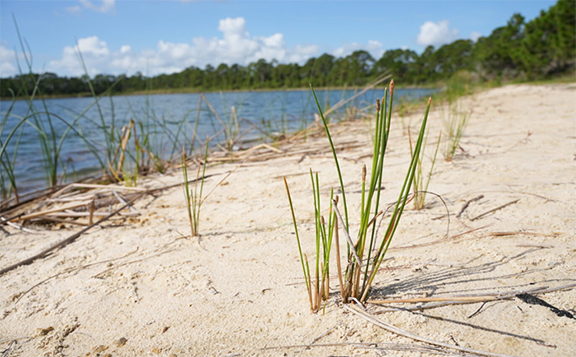 Native plantings conducted by FWC and the City of Port St. Lucie included pickerelweed, swamp lily, bulrush, spikerush, smartweed, and cypress trees and will provide both fish and wildlife habitat and improved angling.
TrophyCatch celebrated its 11th Season as the “Season of Research" as our biologists took a closer look at the more-than-a-decade of data that your TrophyCatch submissions have provided since the citizen-science program launched in 2012. Combined with other research and sampling completed by the FWC, unique TrophyCatch data has generated information simply not obtainable anywhere else. Check the TrophyCatch Research Page for relevant articles about Bass Tagging, Creel Surveys, and correct Bass Handling. Here are some highlights from those articles, but make sure you click that link to learn more!
 |
|
If you catch a tagged bass, clip the tag close to the fish’s back and save the tag. You are not obligated to release tagged bass but must comply with harvest regulations. When you report the tag, an FWC staff member will ask a few brief questions about your catch to help you claim a monetary reward. Be prepared to provide the following information: fish fate (harvest vs. live release), date of catch, weight at catch, fishing method used (artificial lure vs. live bait), tournament participation, and whether you were aware of TrophyCatch and planned to participate with the tagged fish. |
Bass tagging and creel data combined with TrophyCatch submission information indicates that about one out of every five trophy bass living in Florida’s public waters are caught by anglers each year. TrophyCatch requires release of these valuable trophy fish so other anglers can enjoy a lifetime catch. |
|
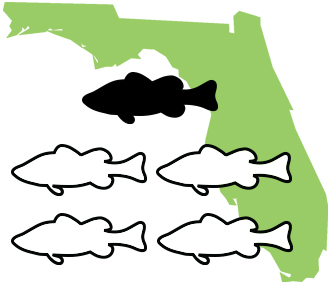 |
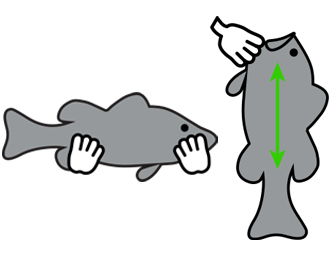 |
|
Detailed testing and monitoring of held-and-released bass showed that these two bass holds are the best:
- Bass held with the full support of two hands recovered fastest when released, in less than 10 seconds on average.
- Bass held vertically by the jaw with a grip device recovered slower, within 33 seconds on average, but with NO major jaw adjustments.
|
Of course, ongoing research will continue as one of the primary components of TrophyCatch and your citizen-science catch submissions to the program. FWC will share more highlights as they are uncovered by YOUR data! Check the TrophyCatch Research Page for more fascinating bass facts.
To contact the Florida Freshwater Angler, email John Cimbaro. Fish illustrations by Duane Raver, Jr. and Diane Rome Peebles.
|